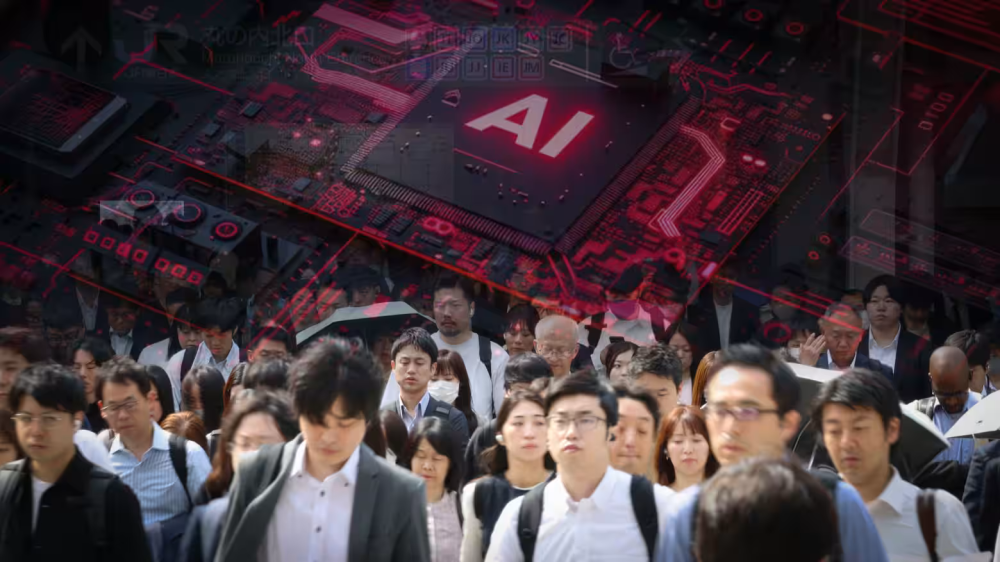Will Fee is a researcher at the Tokyo-based Yuri Group. He is the lead writer of the GxxD series of reports, which explore the intersection between digitalization and green energy in Japan.
"If you're in customer service, call centers, forget about it. Those jobs are already gone."
It was the first day of SushiTech, the Tokyo Metropolitan Government's flagship startup conference held in mid-May, and the theme of the panel in question was the "Global AI Shift."
The speaker was a Silicon Valley-based venture capitalist. He was replete with the latest hiking-gear-turned-business-wear, a look that marked him out as part of the dominant breed of computer geek who, having taken over the Big Tech schoolyard, now calls the shots on the global economic stage.
"Wait, what about sales? That's part of what we do," said a fellow VC on stage, concerned suddenly that AI could one day come for jobs in their own industry.
"Don't worry. If you're dealing in numbers over, say, a hundred grand -- the type of deal where the guy's livelihood is on the line if it falls through -- the client still needs that human touch and the trust element, so those jobs should do just fine."
$100,000 -- no small change. But nice, at least, to get a ballpark figure on the type of jobs worth saving from AI. Everyone else, other people whose livelihoods we might also assume are on the line, can -- apparently -- "forget about it."
Which is a scary insight into not only the mindset of the venture capital world, but also the general direction of travel for AI development in the West.
While the public is sold the epoch-defining benefits of the tech, the moneymen and women behind the AI investment dollars sell "efficiency gains" to businesses, which translates loosely into noncorporate speak as job losses.
Almost every aspect of the recent SushiTech conference in Tokyo was framed through the lens of AI deployment. (Photo by Alexander Farrell)
A range of big Western firms have already begun culling jobs in favor of AI. On Wall Street, the number of AI-related job losses is expected to hit 200,000 over the next three to five years. In May, Microsoft started the process of laying off 6,000 workers (3% of its total workforce) as it makes its own pivot to AI.
And in a taste of things to come across industries, Tobi Lutke -- CEO of Canadian e-commerce platform Shopify -- told staff in a memo in April that "before asking for more headcount and resources, teams must demonstrate why they cannot get what they want done using AI."
Clearly manna from heaven for many of the executive class, the idea that a company could replace large chunks of its wage-earning, rights-holding human workforce with AI is -- on a societal level at least -- a major downside to the runaway growth of the industry.
It's also a notion that's unlikely to fly in the consistently tight job market of Japan.
At 2.5%, Japan has the lowest unemployment rate among all OECD countries, where the average in March this year stood at 4.9%.
Throughout much of the postwar period, employment for all, jobs for life, and a smooth school-to-work transition have been significant aspects of the Japanese social contract -- factors that have contributed to the relative stability of the nation's sociopolitical life throughout much of that period.
Cracks have begun to emerge during the deflationary era of the past 30 years, as neoliberal reforms first introduced by the Koizumi administration in the early 2000s created unstable employment conditions, particularly for women and the young.
Regardless, the perception that work is readily available for those who want it persists, borne out by consistently low levels of unemployment. During a cost-of-living crisis, rampant overtourism, and growing frustration with the weakness of the yen, there is little appetite for a tech "revolution" that would throw the safe political bet of a stable job market into turmoil.
Still, AI remains the dominant theme in Japanese business and political circles. This was typified by the SushiTech conference, where almost every aspect of the event -- including the appearances from headline act, Tokyo Gov. Yuriko Koike -- was framed through the lens of AI deployment.
Why? Because Japan is in fact in desperate need of a technological revolution in its job market. Just not for the same cost-cutting reasons peddled in the West.
Instead, the AI conversation in Japan hinges on the precipitous demographic cliff the country is falling off.
The headline numbers are that the total population of just under 125 million is expected to decline by roughly half by the year 2100. The drop-off is due to a very low birthrate, with annual births last year falling to around 720,000, having reached a peak of over 2 million in the 1970s.
Some 40% of the nation's rural municipalities are expected to die out by 2050, as urban flight sees more and more of the remaining population flock to big cities, principally Tokyo. The ICT industry -- the engine room of any society hoping to compete in a rapidly digitizing world -- will this year face a shortfall of almost half a million workers. The overall shortfall in the working age population is expected to reach 3.8 million people in 2035.
One solution could be increased immigration. But Japan is already home to a record 3.4 million foreign nationals. For a country with a history that includes a centuries-long period of complete isolation from the outside world, drastically increased immigration beyond those numbers is unlikely.
Which really only leaves one option -- innovation, with AI development in particular slowly emerging as a feasible method for plugging holes in the labor market.
Domestic startups like Agrist and AgriD are applying AI in robotics to supplement the nation's rapidly ageing pool of working farmers -- a population of 1.23 million in 2022 that is expected to decline by 75% over the next two decades.
Insurance giant Sompo Holdings has introduced AI-backed sleep monitoring services in elderly care homes that it says can alleviate the burden on overworked staff responsible for the care of Japan's 36.25 million-strong elderly population.
And in one particularly interesting turn, Japanese recruitment startups -- companies like samurAI Agents and Qlay -- are using AI to help recruitment specialists fill open roles with suitable candidates, rather than using that very same tech to replace them.
Japan may yet take the "efficiencies" route driving AI deployment in the West. One Tokyo government panel at SushiTech briefly touched on the AI-related hit to white-collar jobs seen already in fields like insurance.
But given its glaring demographic issues, Japan also has a shot at more human-centric, socially valuable AI deployments -- applications that complement rather than cannibalize a diminishing workforce.
Innovators, entrepreneurs and public officials would do well to keep sight of this goal as Japan's AI scene develops. That way, the tech might remain a genuine force for good, rather than the source of employment anxiety and even existential angst it has become for many in the West.




